Analysis of Leadership and Change at FLY-HIGH Airline
VerifiedAdded on 2021/04/19
|8
|2140
|39
Report
AI Summary
This report provides a comprehensive analysis of the leadership transformation at FLY-HIGH Airline. It begins by outlining the challenges faced by the airline, including high operational costs and the need for change. The report examines the appointment of a new CEO, Roger Turnaround, and his implementation of transformational leadership and change management strategies. It details the multi-pronged approach adopted by Roger, including fleet standardization, multi-training programs, re-branding, and revised mileage programs. The report highlights the impact of these initiatives, such as cost reduction, increased revenue, and improved employee engagement. Furthermore, it discusses the shift from a management paradigm to a leadership paradigm, emphasizing the importance of employee involvement and stakeholder collaboration in achieving successful change. The report concludes by evaluating the effectiveness of Roger's leadership in revitalizing FLY-HIGH Airline and its impact on the airline's overall performance and market position.
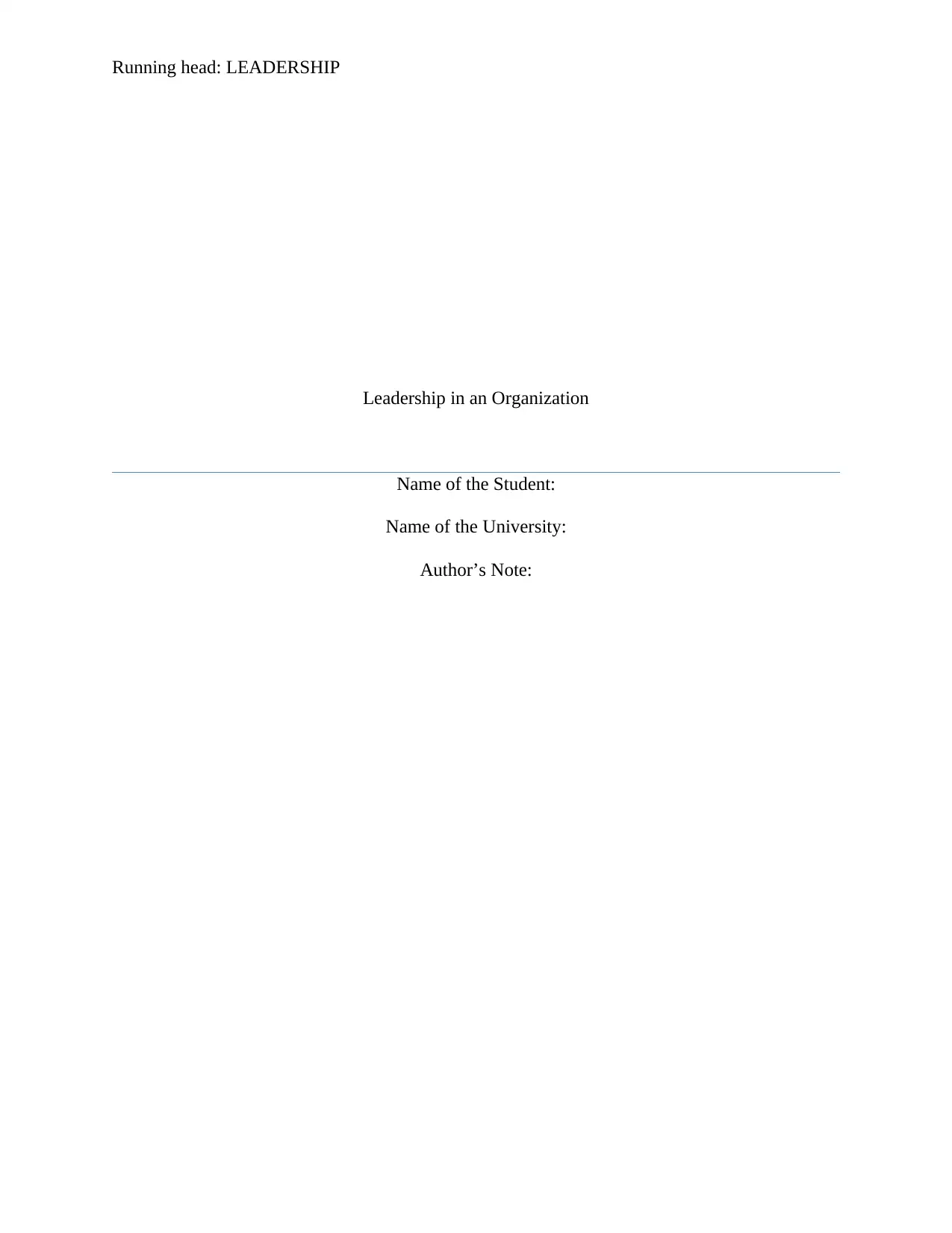
Running head: LEADERSHIP
Leadership in an Organization
Name of the Student:
Name of the University:
Author’s Note:
Leadership in an Organization
Name of the Student:
Name of the University:
Author’s Note:
Paraphrase This Document
Need a fresh take? Get an instant paraphrase of this document with our AI Paraphraser
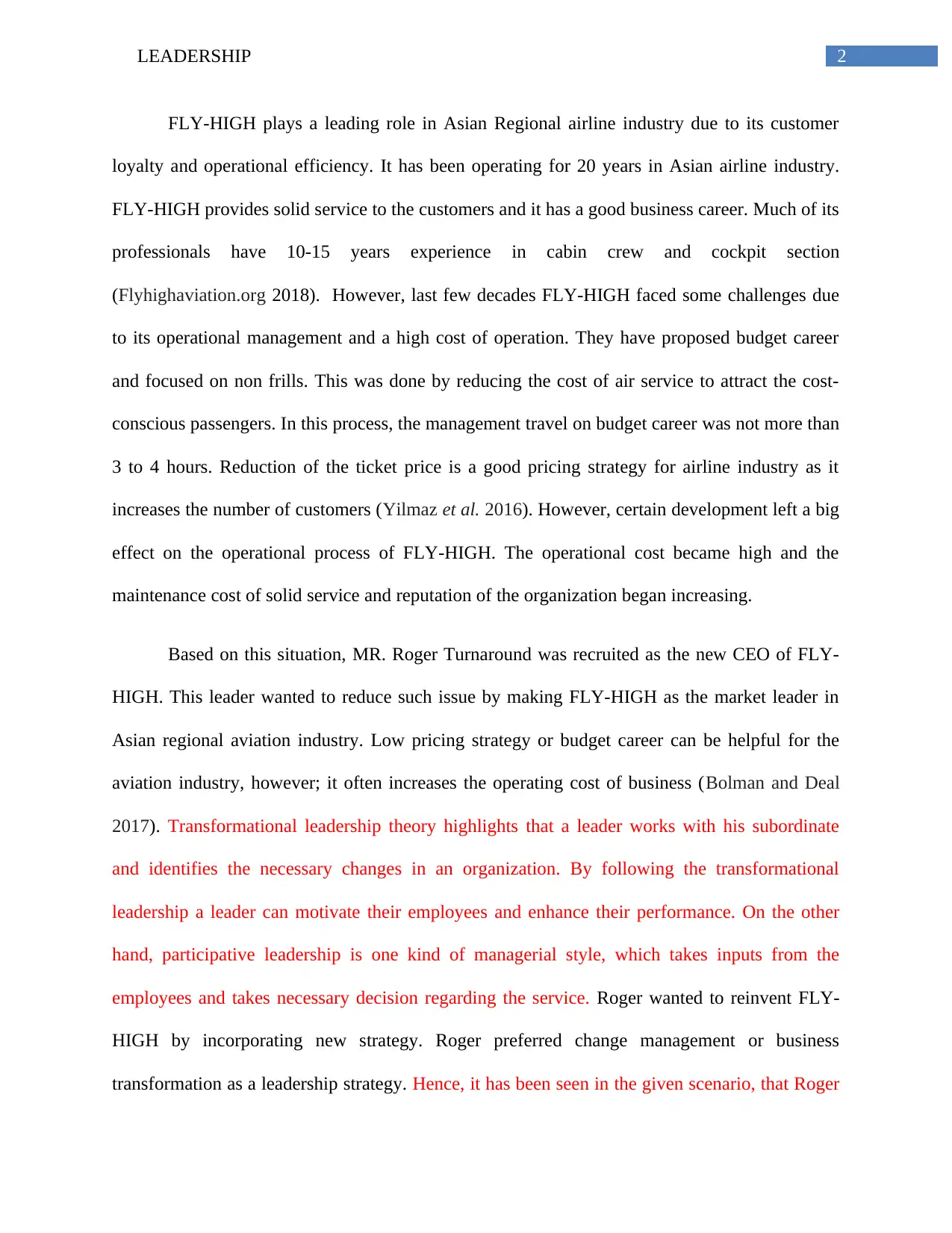
2LEADERSHIP
FLY-HIGH plays a leading role in Asian Regional airline industry due to its customer
loyalty and operational efficiency. It has been operating for 20 years in Asian airline industry.
FLY-HIGH provides solid service to the customers and it has a good business career. Much of its
professionals have 10-15 years experience in cabin crew and cockpit section
(Flyhighaviation.org 2018). However, last few decades FLY-HIGH faced some challenges due
to its operational management and a high cost of operation. They have proposed budget career
and focused on non frills. This was done by reducing the cost of air service to attract the cost-
conscious passengers. In this process, the management travel on budget career was not more than
3 to 4 hours. Reduction of the ticket price is a good pricing strategy for airline industry as it
increases the number of customers (Yilmaz et al. 2016). However, certain development left a big
effect on the operational process of FLY-HIGH. The operational cost became high and the
maintenance cost of solid service and reputation of the organization began increasing.
Based on this situation, MR. Roger Turnaround was recruited as the new CEO of FLY-
HIGH. This leader wanted to reduce such issue by making FLY-HIGH as the market leader in
Asian regional aviation industry. Low pricing strategy or budget career can be helpful for the
aviation industry, however; it often increases the operating cost of business (Bolman and Deal
2017). Transformational leadership theory highlights that a leader works with his subordinate
and identifies the necessary changes in an organization. By following the transformational
leadership a leader can motivate their employees and enhance their performance. On the other
hand, participative leadership is one kind of managerial style, which takes inputs from the
employees and takes necessary decision regarding the service. Roger wanted to reinvent FLY-
HIGH by incorporating new strategy. Roger preferred change management or business
transformation as a leadership strategy. Hence, it has been seen in the given scenario, that Roger
FLY-HIGH plays a leading role in Asian Regional airline industry due to its customer
loyalty and operational efficiency. It has been operating for 20 years in Asian airline industry.
FLY-HIGH provides solid service to the customers and it has a good business career. Much of its
professionals have 10-15 years experience in cabin crew and cockpit section
(Flyhighaviation.org 2018). However, last few decades FLY-HIGH faced some challenges due
to its operational management and a high cost of operation. They have proposed budget career
and focused on non frills. This was done by reducing the cost of air service to attract the cost-
conscious passengers. In this process, the management travel on budget career was not more than
3 to 4 hours. Reduction of the ticket price is a good pricing strategy for airline industry as it
increases the number of customers (Yilmaz et al. 2016). However, certain development left a big
effect on the operational process of FLY-HIGH. The operational cost became high and the
maintenance cost of solid service and reputation of the organization began increasing.
Based on this situation, MR. Roger Turnaround was recruited as the new CEO of FLY-
HIGH. This leader wanted to reduce such issue by making FLY-HIGH as the market leader in
Asian regional aviation industry. Low pricing strategy or budget career can be helpful for the
aviation industry, however; it often increases the operating cost of business (Bolman and Deal
2017). Transformational leadership theory highlights that a leader works with his subordinate
and identifies the necessary changes in an organization. By following the transformational
leadership a leader can motivate their employees and enhance their performance. On the other
hand, participative leadership is one kind of managerial style, which takes inputs from the
employees and takes necessary decision regarding the service. Roger wanted to reinvent FLY-
HIGH by incorporating new strategy. Roger preferred change management or business
transformation as a leadership strategy. Hence, it has been seen in the given scenario, that Roger
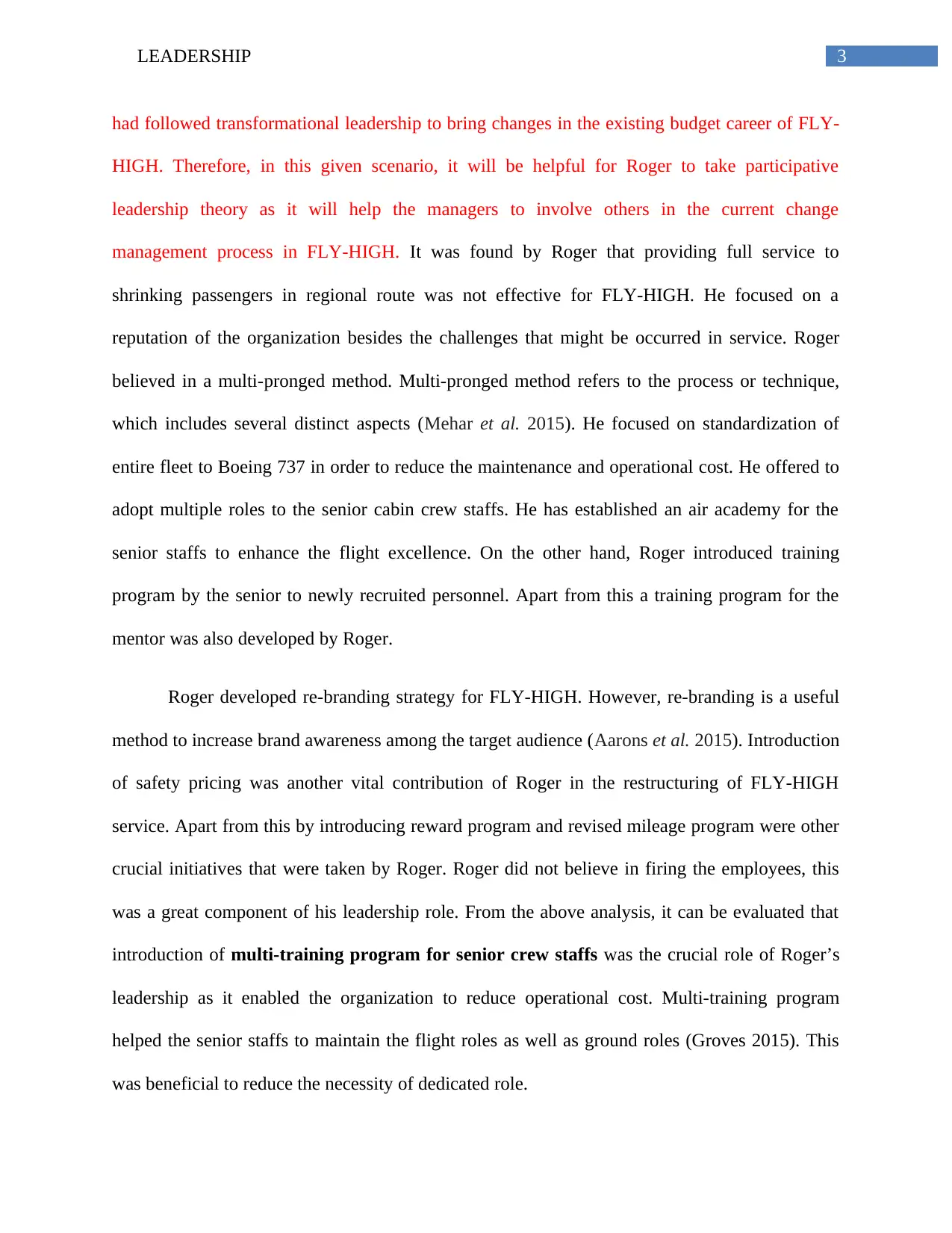
3LEADERSHIP
had followed transformational leadership to bring changes in the existing budget career of FLY-
HIGH. Therefore, in this given scenario, it will be helpful for Roger to take participative
leadership theory as it will help the managers to involve others in the current change
management process in FLY-HIGH. It was found by Roger that providing full service to
shrinking passengers in regional route was not effective for FLY-HIGH. He focused on a
reputation of the organization besides the challenges that might be occurred in service. Roger
believed in a multi-pronged method. Multi-pronged method refers to the process or technique,
which includes several distinct aspects (Mehar et al. 2015). He focused on standardization of
entire fleet to Boeing 737 in order to reduce the maintenance and operational cost. He offered to
adopt multiple roles to the senior cabin crew staffs. He has established an air academy for the
senior staffs to enhance the flight excellence. On the other hand, Roger introduced training
program by the senior to newly recruited personnel. Apart from this a training program for the
mentor was also developed by Roger.
Roger developed re-branding strategy for FLY-HIGH. However, re-branding is a useful
method to increase brand awareness among the target audience (Aarons et al. 2015). Introduction
of safety pricing was another vital contribution of Roger in the restructuring of FLY-HIGH
service. Apart from this by introducing reward program and revised mileage program were other
crucial initiatives that were taken by Roger. Roger did not believe in firing the employees, this
was a great component of his leadership role. From the above analysis, it can be evaluated that
introduction of multi-training program for senior crew staffs was the crucial role of Roger’s
leadership as it enabled the organization to reduce operational cost. Multi-training program
helped the senior staffs to maintain the flight roles as well as ground roles (Groves 2015). This
was beneficial to reduce the necessity of dedicated role.
had followed transformational leadership to bring changes in the existing budget career of FLY-
HIGH. Therefore, in this given scenario, it will be helpful for Roger to take participative
leadership theory as it will help the managers to involve others in the current change
management process in FLY-HIGH. It was found by Roger that providing full service to
shrinking passengers in regional route was not effective for FLY-HIGH. He focused on a
reputation of the organization besides the challenges that might be occurred in service. Roger
believed in a multi-pronged method. Multi-pronged method refers to the process or technique,
which includes several distinct aspects (Mehar et al. 2015). He focused on standardization of
entire fleet to Boeing 737 in order to reduce the maintenance and operational cost. He offered to
adopt multiple roles to the senior cabin crew staffs. He has established an air academy for the
senior staffs to enhance the flight excellence. On the other hand, Roger introduced training
program by the senior to newly recruited personnel. Apart from this a training program for the
mentor was also developed by Roger.
Roger developed re-branding strategy for FLY-HIGH. However, re-branding is a useful
method to increase brand awareness among the target audience (Aarons et al. 2015). Introduction
of safety pricing was another vital contribution of Roger in the restructuring of FLY-HIGH
service. Apart from this by introducing reward program and revised mileage program were other
crucial initiatives that were taken by Roger. Roger did not believe in firing the employees, this
was a great component of his leadership role. From the above analysis, it can be evaluated that
introduction of multi-training program for senior crew staffs was the crucial role of Roger’s
leadership as it enabled the organization to reduce operational cost. Multi-training program
helped the senior staffs to maintain the flight roles as well as ground roles (Groves 2015). This
was beneficial to reduce the necessity of dedicated role.
⊘ This is a preview!⊘
Do you want full access?
Subscribe today to unlock all pages.

Trusted by 1+ million students worldwide
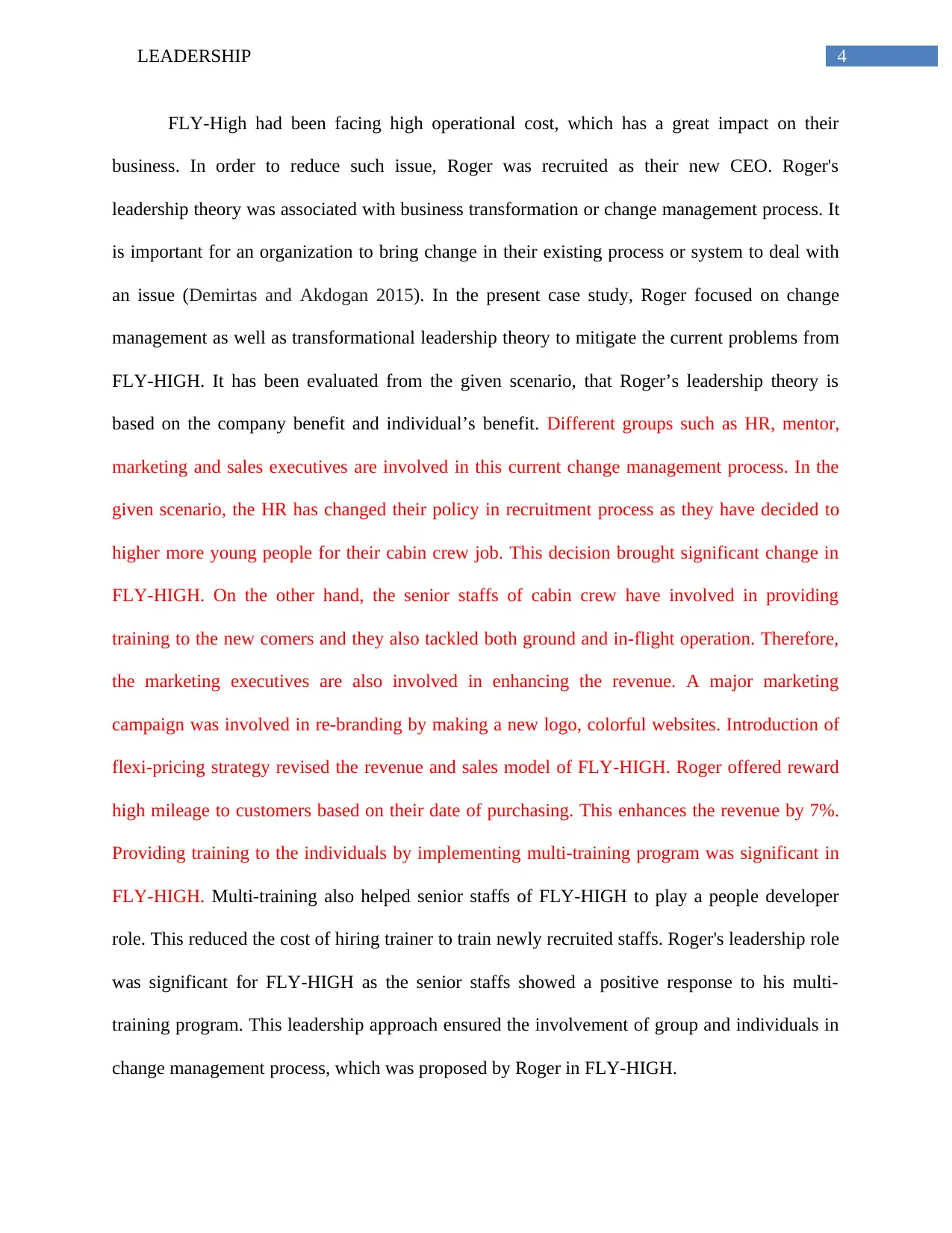
4LEADERSHIP
FLY-High had been facing high operational cost, which has a great impact on their
business. In order to reduce such issue, Roger was recruited as their new CEO. Roger's
leadership theory was associated with business transformation or change management process. It
is important for an organization to bring change in their existing process or system to deal with
an issue (Demirtas and Akdogan 2015). In the present case study, Roger focused on change
management as well as transformational leadership theory to mitigate the current problems from
FLY-HIGH. It has been evaluated from the given scenario, that Roger’s leadership theory is
based on the company benefit and individual’s benefit. Different groups such as HR, mentor,
marketing and sales executives are involved in this current change management process. In the
given scenario, the HR has changed their policy in recruitment process as they have decided to
higher more young people for their cabin crew job. This decision brought significant change in
FLY-HIGH. On the other hand, the senior staffs of cabin crew have involved in providing
training to the new comers and they also tackled both ground and in-flight operation. Therefore,
the marketing executives are also involved in enhancing the revenue. A major marketing
campaign was involved in re-branding by making a new logo, colorful websites. Introduction of
flexi-pricing strategy revised the revenue and sales model of FLY-HIGH. Roger offered reward
high mileage to customers based on their date of purchasing. This enhances the revenue by 7%.
Providing training to the individuals by implementing multi-training program was significant in
FLY-HIGH. Multi-training also helped senior staffs of FLY-HIGH to play a people developer
role. This reduced the cost of hiring trainer to train newly recruited staffs. Roger's leadership role
was significant for FLY-HIGH as the senior staffs showed a positive response to his multi-
training program. This leadership approach ensured the involvement of group and individuals in
change management process, which was proposed by Roger in FLY-HIGH.
FLY-High had been facing high operational cost, which has a great impact on their
business. In order to reduce such issue, Roger was recruited as their new CEO. Roger's
leadership theory was associated with business transformation or change management process. It
is important for an organization to bring change in their existing process or system to deal with
an issue (Demirtas and Akdogan 2015). In the present case study, Roger focused on change
management as well as transformational leadership theory to mitigate the current problems from
FLY-HIGH. It has been evaluated from the given scenario, that Roger’s leadership theory is
based on the company benefit and individual’s benefit. Different groups such as HR, mentor,
marketing and sales executives are involved in this current change management process. In the
given scenario, the HR has changed their policy in recruitment process as they have decided to
higher more young people for their cabin crew job. This decision brought significant change in
FLY-HIGH. On the other hand, the senior staffs of cabin crew have involved in providing
training to the new comers and they also tackled both ground and in-flight operation. Therefore,
the marketing executives are also involved in enhancing the revenue. A major marketing
campaign was involved in re-branding by making a new logo, colorful websites. Introduction of
flexi-pricing strategy revised the revenue and sales model of FLY-HIGH. Roger offered reward
high mileage to customers based on their date of purchasing. This enhances the revenue by 7%.
Providing training to the individuals by implementing multi-training program was significant in
FLY-HIGH. Multi-training also helped senior staffs of FLY-HIGH to play a people developer
role. This reduced the cost of hiring trainer to train newly recruited staffs. Roger's leadership role
was significant for FLY-HIGH as the senior staffs showed a positive response to his multi-
training program. This leadership approach ensured the involvement of group and individuals in
change management process, which was proposed by Roger in FLY-HIGH.
Paraphrase This Document
Need a fresh take? Get an instant paraphrase of this document with our AI Paraphraser
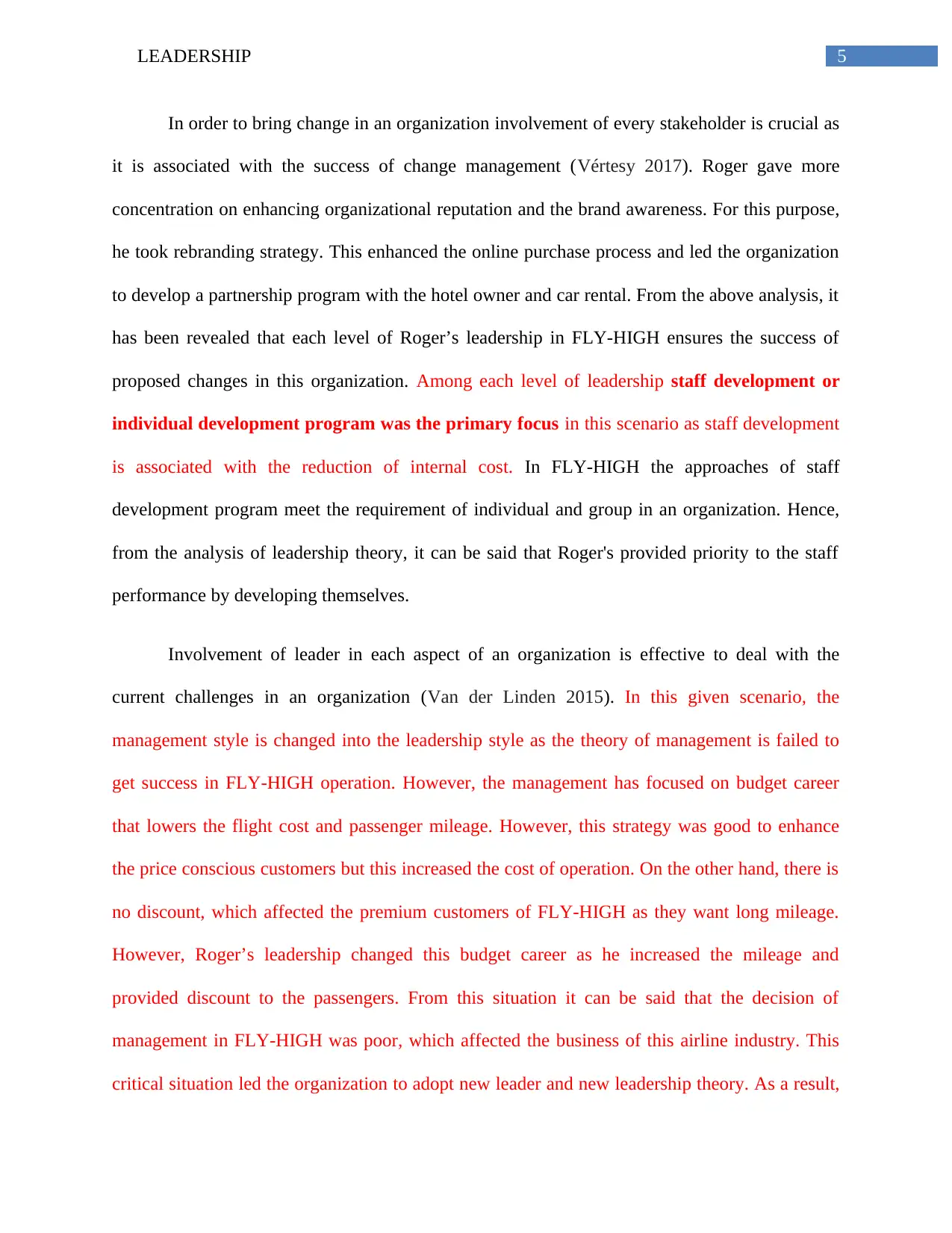
5LEADERSHIP
In order to bring change in an organization involvement of every stakeholder is crucial as
it is associated with the success of change management (Vértesy 2017). Roger gave more
concentration on enhancing organizational reputation and the brand awareness. For this purpose,
he took rebranding strategy. This enhanced the online purchase process and led the organization
to develop a partnership program with the hotel owner and car rental. From the above analysis, it
has been revealed that each level of Roger’s leadership in FLY-HIGH ensures the success of
proposed changes in this organization. Among each level of leadership staff development or
individual development program was the primary focus in this scenario as staff development
is associated with the reduction of internal cost. In FLY-HIGH the approaches of staff
development program meet the requirement of individual and group in an organization. Hence,
from the analysis of leadership theory, it can be said that Roger's provided priority to the staff
performance by developing themselves.
Involvement of leader in each aspect of an organization is effective to deal with the
current challenges in an organization (Van der Linden 2015). In this given scenario, the
management style is changed into the leadership style as the theory of management is failed to
get success in FLY-HIGH operation. However, the management has focused on budget career
that lowers the flight cost and passenger mileage. However, this strategy was good to enhance
the price conscious customers but this increased the cost of operation. On the other hand, there is
no discount, which affected the premium customers of FLY-HIGH as they want long mileage.
However, Roger’s leadership changed this budget career as he increased the mileage and
provided discount to the passengers. From this situation it can be said that the decision of
management in FLY-HIGH was poor, which affected the business of this airline industry. This
critical situation led the organization to adopt new leader and new leadership theory. As a result,
In order to bring change in an organization involvement of every stakeholder is crucial as
it is associated with the success of change management (Vértesy 2017). Roger gave more
concentration on enhancing organizational reputation and the brand awareness. For this purpose,
he took rebranding strategy. This enhanced the online purchase process and led the organization
to develop a partnership program with the hotel owner and car rental. From the above analysis, it
has been revealed that each level of Roger’s leadership in FLY-HIGH ensures the success of
proposed changes in this organization. Among each level of leadership staff development or
individual development program was the primary focus in this scenario as staff development
is associated with the reduction of internal cost. In FLY-HIGH the approaches of staff
development program meet the requirement of individual and group in an organization. Hence,
from the analysis of leadership theory, it can be said that Roger's provided priority to the staff
performance by developing themselves.
Involvement of leader in each aspect of an organization is effective to deal with the
current challenges in an organization (Van der Linden 2015). In this given scenario, the
management style is changed into the leadership style as the theory of management is failed to
get success in FLY-HIGH operation. However, the management has focused on budget career
that lowers the flight cost and passenger mileage. However, this strategy was good to enhance
the price conscious customers but this increased the cost of operation. On the other hand, there is
no discount, which affected the premium customers of FLY-HIGH as they want long mileage.
However, Roger’s leadership changed this budget career as he increased the mileage and
provided discount to the passengers. From this situation it can be said that the decision of
management in FLY-HIGH was poor, which affected the business of this airline industry. This
critical situation led the organization to adopt new leader and new leadership theory. As a result,
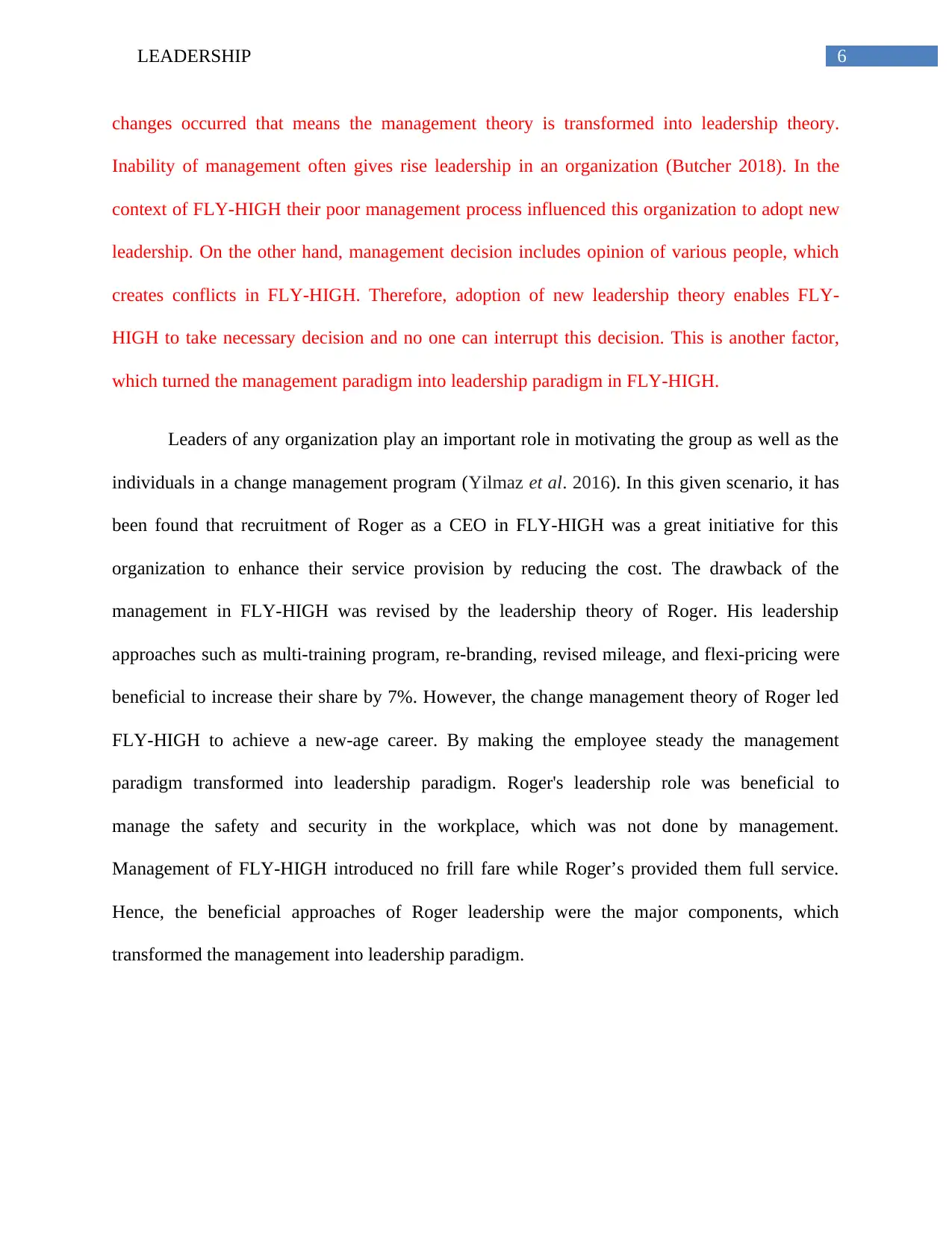
6LEADERSHIP
changes occurred that means the management theory is transformed into leadership theory.
Inability of management often gives rise leadership in an organization (Butcher 2018). In the
context of FLY-HIGH their poor management process influenced this organization to adopt new
leadership. On the other hand, management decision includes opinion of various people, which
creates conflicts in FLY-HIGH. Therefore, adoption of new leadership theory enables FLY-
HIGH to take necessary decision and no one can interrupt this decision. This is another factor,
which turned the management paradigm into leadership paradigm in FLY-HIGH.
Leaders of any organization play an important role in motivating the group as well as the
individuals in a change management program (Yilmaz et al. 2016). In this given scenario, it has
been found that recruitment of Roger as a CEO in FLY-HIGH was a great initiative for this
organization to enhance their service provision by reducing the cost. The drawback of the
management in FLY-HIGH was revised by the leadership theory of Roger. His leadership
approaches such as multi-training program, re-branding, revised mileage, and flexi-pricing were
beneficial to increase their share by 7%. However, the change management theory of Roger led
FLY-HIGH to achieve a new-age career. By making the employee steady the management
paradigm transformed into leadership paradigm. Roger's leadership role was beneficial to
manage the safety and security in the workplace, which was not done by management.
Management of FLY-HIGH introduced no frill fare while Roger’s provided them full service.
Hence, the beneficial approaches of Roger leadership were the major components, which
transformed the management into leadership paradigm.
changes occurred that means the management theory is transformed into leadership theory.
Inability of management often gives rise leadership in an organization (Butcher 2018). In the
context of FLY-HIGH their poor management process influenced this organization to adopt new
leadership. On the other hand, management decision includes opinion of various people, which
creates conflicts in FLY-HIGH. Therefore, adoption of new leadership theory enables FLY-
HIGH to take necessary decision and no one can interrupt this decision. This is another factor,
which turned the management paradigm into leadership paradigm in FLY-HIGH.
Leaders of any organization play an important role in motivating the group as well as the
individuals in a change management program (Yilmaz et al. 2016). In this given scenario, it has
been found that recruitment of Roger as a CEO in FLY-HIGH was a great initiative for this
organization to enhance their service provision by reducing the cost. The drawback of the
management in FLY-HIGH was revised by the leadership theory of Roger. His leadership
approaches such as multi-training program, re-branding, revised mileage, and flexi-pricing were
beneficial to increase their share by 7%. However, the change management theory of Roger led
FLY-HIGH to achieve a new-age career. By making the employee steady the management
paradigm transformed into leadership paradigm. Roger's leadership role was beneficial to
manage the safety and security in the workplace, which was not done by management.
Management of FLY-HIGH introduced no frill fare while Roger’s provided them full service.
Hence, the beneficial approaches of Roger leadership were the major components, which
transformed the management into leadership paradigm.
⊘ This is a preview!⊘
Do you want full access?
Subscribe today to unlock all pages.

Trusted by 1+ million students worldwide
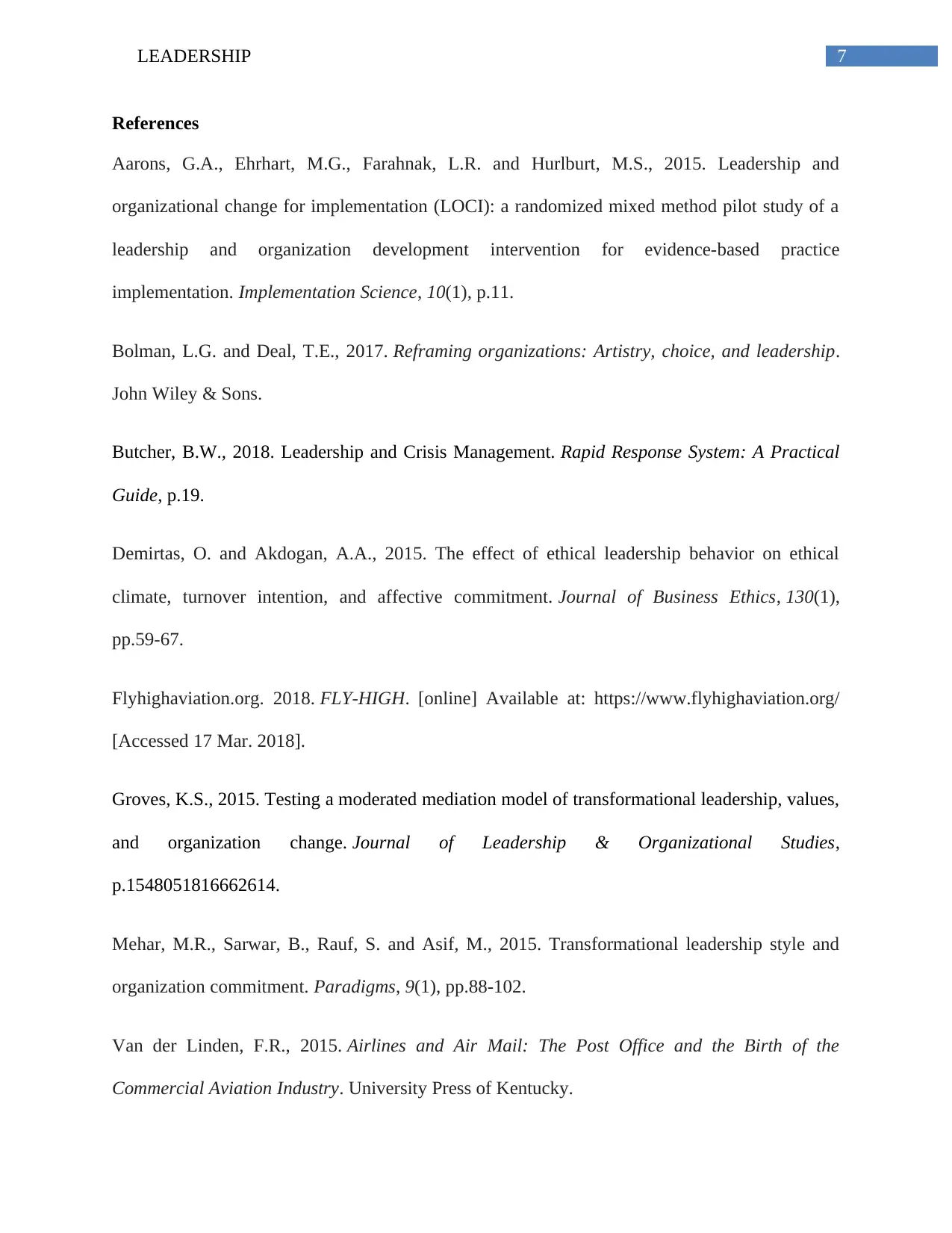
7LEADERSHIP
References
Aarons, G.A., Ehrhart, M.G., Farahnak, L.R. and Hurlburt, M.S., 2015. Leadership and
organizational change for implementation (LOCI): a randomized mixed method pilot study of a
leadership and organization development intervention for evidence-based practice
implementation. Implementation Science, 10(1), p.11.
Bolman, L.G. and Deal, T.E., 2017. Reframing organizations: Artistry, choice, and leadership.
John Wiley & Sons.
Butcher, B.W., 2018. Leadership and Crisis Management. Rapid Response System: A Practical
Guide, p.19.
Demirtas, O. and Akdogan, A.A., 2015. The effect of ethical leadership behavior on ethical
climate, turnover intention, and affective commitment. Journal of Business Ethics, 130(1),
pp.59-67.
Flyhighaviation.org. 2018. FLY-HIGH. [online] Available at: https://www.flyhighaviation.org/
[Accessed 17 Mar. 2018].
Groves, K.S., 2015. Testing a moderated mediation model of transformational leadership, values,
and organization change. Journal of Leadership & Organizational Studies,
p.1548051816662614.
Mehar, M.R., Sarwar, B., Rauf, S. and Asif, M., 2015. Transformational leadership style and
organization commitment. Paradigms, 9(1), pp.88-102.
Van der Linden, F.R., 2015. Airlines and Air Mail: The Post Office and the Birth of the
Commercial Aviation Industry. University Press of Kentucky.
References
Aarons, G.A., Ehrhart, M.G., Farahnak, L.R. and Hurlburt, M.S., 2015. Leadership and
organizational change for implementation (LOCI): a randomized mixed method pilot study of a
leadership and organization development intervention for evidence-based practice
implementation. Implementation Science, 10(1), p.11.
Bolman, L.G. and Deal, T.E., 2017. Reframing organizations: Artistry, choice, and leadership.
John Wiley & Sons.
Butcher, B.W., 2018. Leadership and Crisis Management. Rapid Response System: A Practical
Guide, p.19.
Demirtas, O. and Akdogan, A.A., 2015. The effect of ethical leadership behavior on ethical
climate, turnover intention, and affective commitment. Journal of Business Ethics, 130(1),
pp.59-67.
Flyhighaviation.org. 2018. FLY-HIGH. [online] Available at: https://www.flyhighaviation.org/
[Accessed 17 Mar. 2018].
Groves, K.S., 2015. Testing a moderated mediation model of transformational leadership, values,
and organization change. Journal of Leadership & Organizational Studies,
p.1548051816662614.
Mehar, M.R., Sarwar, B., Rauf, S. and Asif, M., 2015. Transformational leadership style and
organization commitment. Paradigms, 9(1), pp.88-102.
Van der Linden, F.R., 2015. Airlines and Air Mail: The Post Office and the Birth of the
Commercial Aviation Industry. University Press of Kentucky.
Paraphrase This Document
Need a fresh take? Get an instant paraphrase of this document with our AI Paraphraser
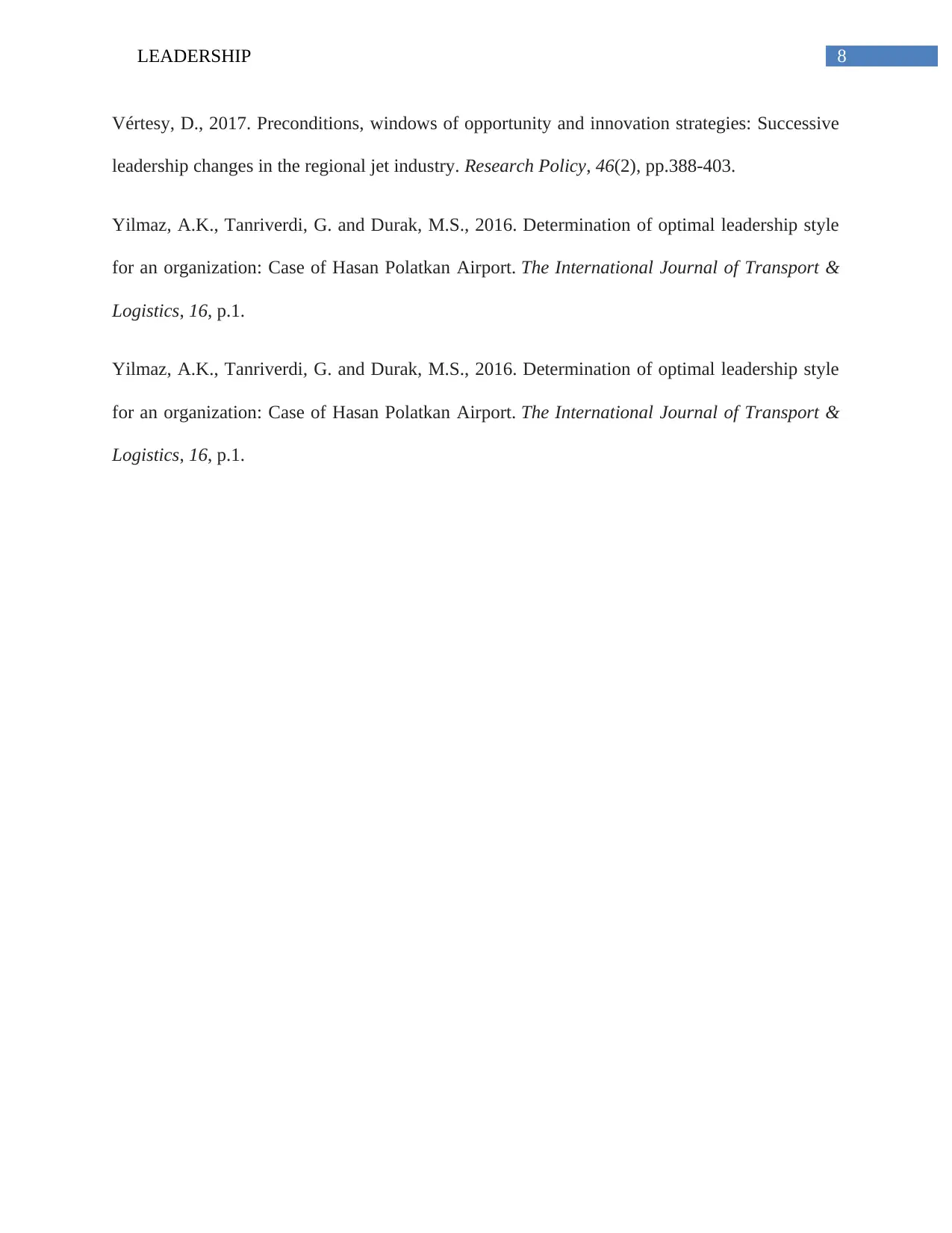
8LEADERSHIP
Vértesy, D., 2017. Preconditions, windows of opportunity and innovation strategies: Successive
leadership changes in the regional jet industry. Research Policy, 46(2), pp.388-403.
Yilmaz, A.K., Tanriverdi, G. and Durak, M.S., 2016. Determination of optimal leadership style
for an organization: Case of Hasan Polatkan Airport. The International Journal of Transport &
Logistics, 16, p.1.
Yilmaz, A.K., Tanriverdi, G. and Durak, M.S., 2016. Determination of optimal leadership style
for an organization: Case of Hasan Polatkan Airport. The International Journal of Transport &
Logistics, 16, p.1.
Vértesy, D., 2017. Preconditions, windows of opportunity and innovation strategies: Successive
leadership changes in the regional jet industry. Research Policy, 46(2), pp.388-403.
Yilmaz, A.K., Tanriverdi, G. and Durak, M.S., 2016. Determination of optimal leadership style
for an organization: Case of Hasan Polatkan Airport. The International Journal of Transport &
Logistics, 16, p.1.
Yilmaz, A.K., Tanriverdi, G. and Durak, M.S., 2016. Determination of optimal leadership style
for an organization: Case of Hasan Polatkan Airport. The International Journal of Transport &
Logistics, 16, p.1.
1 out of 8
Related Documents
Your All-in-One AI-Powered Toolkit for Academic Success.
+13062052269
info@desklib.com
Available 24*7 on WhatsApp / Email
![[object Object]](/_next/static/media/star-bottom.7253800d.svg)
Unlock your academic potential
Copyright © 2020–2025 A2Z Services. All Rights Reserved. Developed and managed by ZUCOL.





